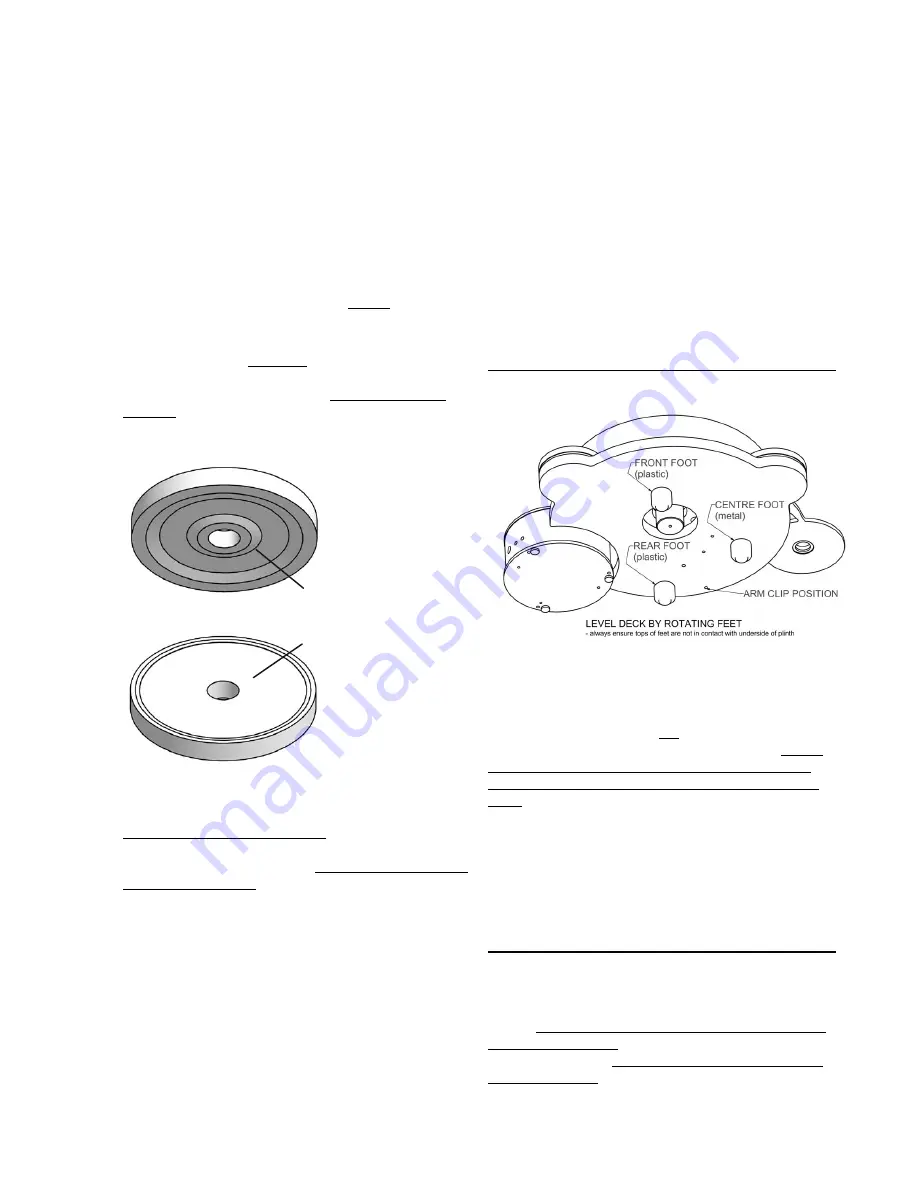
Page 4
house. You can “feel” overflow when inserting the spindle, it
meets resistance at the bottom which is not a “thud” of the
spindle hitting the bottom but rather a build up of pressure of
the bearing landing on a bed of oil. By further pressing, you can
then see the oil being squeezed out at the top.
Carefully lower the platter over the spindle till it rests on the
lower flange of the platter bush (ensure mating surfaces are
clean). Once the platter is fitted over the bush it pays to spin it
slowly by hand while holding the top of the spindle stationary
with your other hand - this helps the platter to “bed down”
onto the bush and become more level.
SOVEREIGN DECK ONLY
: NOTE - On newer decks
(April 2009 onwards) the sub-platter is a “loose” fit over the
spindle and can detatch from the sub-platter.
Wipe the sub-platter spindle surface first to ensure that it
is absolutely clean and very gently insert it into the bearing
house (If the oil does not overflow when the spindle touches
the bottom then try 2 drops at a time
till you just achieve
overflow
- wipe away excess oil without withdrawing the sub-
platter. Next place the sub-platter on the spindle such that the
less recessed side is uppermost.
UNDERSIDE OF
SUB-PLATTER
TOPSIDE OF
SUB-PLATTER
Lastly, place the platter on top of the sub-platter and follow this
with the thin black platter mat .
If you have the heavyweight platter
then raise the plinth more
than normal by winding out the adjustable feet, till the platter
no longer fouls on the motor pod. The belt must NOT run in
the groove of the platter. Do not tighten up the allen bolts in
the underside of the platter - these sound best with minimum
tension.
NOTES:
The bearing fit is carefully toleranced to run fully loaded
with the specific oil we supply. It needs at least 10 minutes to
distribute the oil evenly over the running surfaces and approx
24 hours to properly “run in”. It needs this because of the exact
tolerances (0.0001”)which “float” the bearing off the side walls
to avoid metal to metal contact and also minimize viscous drag.
Eventually it should run virtually silent when truly vertical
and full of oil
- if it doesn’t do so, there has probably been
contamination with dust and you will need to clean it out with
a lint free paper towel or similar wrapped around a thin rod. If
you do this, be sure to also wipe the oil off the spindle as this
also may contain microscopic contamination that is not visible.
Do not use any other oil than Origin Live oil.
Do not tamper with the bolt in the bottom of the bearing
or oil leaks will occur and you will probably not succeed in
re-tightening it.
The thrust plate at the bottom of the bearing house may
appear to be discoloured or dirty - you should not attempt
to clean this up as it is part of the hardening process - the
centre of the plate is polished as this is the only part that
the spindle touches.
The Platter works best with the Origin Live platter mats but these are
not necessarily included in the lower part of the deck range - all of the
many other mats we have tried do not work on the OL decks.
L E V E L T H E D E C K
The 3 feet under the plinth are all threaded so that by rotating
them you can adjust the level of the deck - Rotate all three feet
so that the top of the foot does
not
touch the plinth and only
sits on the thread alone - this is for best performance.
At this
stage check that the bearing house is at least 1mm clear
of touching the surface your deck is standing on (Aurora
only).
Note that when you level the deck, the only thing that matters
is that the platter (not the plinth) is level. Sometimes there
may be a slight discrepancy between the level of the plinth and
platter but this does not matter and is usually imperceptible
visually.
P O S I T I O N M O T O R P O D & F I T
B E L T
Position the motor pod roughly as shown in previous diagrams.
The pod should be oriented as shown, such that the switch is at
the front. Ideally the centre of the pulley should be somewhere
between
215mm (8.45inches) to 225mm (8.9 inches)
from
the centre of the platter.
We recommend and set up the speed
at factory at 217mm
. The pod must not touch the plinth so
rotate it if necessary. Fit the belt over the platter first and then
pull it over the motor pulley taking care not to twist it.
Summary of Contents for Aurora MKII
Page 9: ...Page 9...




























